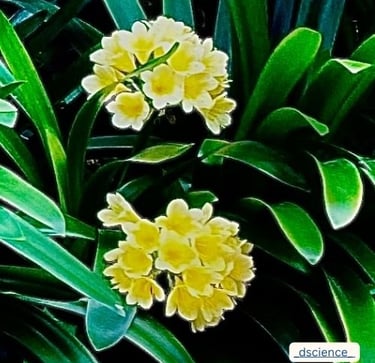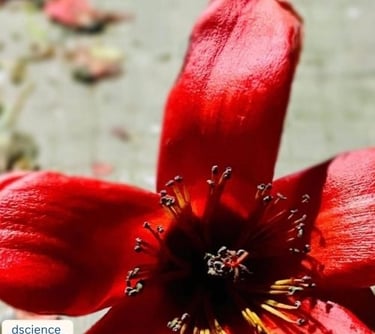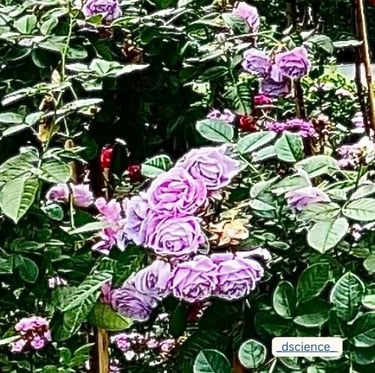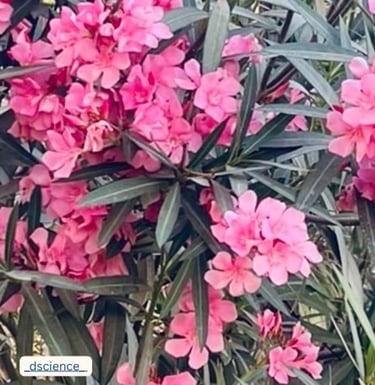The Chemistry of Flowers: Nature's Colourful Chemistry Lab
10/5/20249 min read


Floriography
What Flowers Represent
Flowers have long served as powerful symbols across various cultures and historical contexts, embodying emotions, messages, and traditions. The language of flowers, known as "floriography," assigns specific meanings to different blooms, allowing individuals to communicate sentiments that may be difficult to express verbally. For instance, the red rose is universally recognized as a symbol of love and passion, while the lily often signifies purity and transience.
Throughout history, cultures have ascribed unique meanings to flowers that reflect their societal values and beliefs. In ancient Greece, for example, the narcissus was associated with vanity and self-love, while in Japan, the cherry blossom (sakura) symbolizes the transient nature of life, aligning with the cultural appreciation for the beauty of impermanence.
The impact of color in flower symbolism cannot be understated. Each hue can carry its own connotations; for example, yellow flowers often represent friendship and joy, whereas purple flowers are frequently linked with royalty and ambition. Furthermore, the scent of flowers contributes to their emotive power, with aromatic blooms like jasmine evoking feelings of romance and sensuality, while fragrant herbs such as rosemary are associated with remembrance.
In contemporary culture, the significance of flowers continues to thrive, often serving as a staple in celebrations such as weddings, where white flowers symbolize new beginnings and purity, or funerals, where they represent respect and remembrance. Through their beauty, diversity, and sensory attributes, flowers remain integral to human expression, bridging emotions and occasions across time and space.
Composition of Flowers
Flowers are intricate biological entities composed of various structural components that serve critical roles in reproduction and the attraction of pollinators. The primary parts of a flower include petals, sepals, stamens, and carpels, each contributing significantly to its overall anatomy and facilitating several essential functions.
Petals, often brightly colored, are perhaps the most recognizable part of a flower. Their vibrant colors and patterns attract pollinators such as bees, birds, and butterflies, fostering the process of pollination. This interaction is pivotal as it leads to the fertilization of ovules and ultimately the production of seeds. The color and shape of petals can also be linked to the specific pollinators that a flower aims to attract, showcasing a fascinating example of co-evolution between plants and animals.
Surrounding the petals are sepals, which typically serve as protective layers during the formation of the flower bud. While they may be less colorful, they play an essential role in shielding the delicate petals and reproductive structures from environmental hazards and predators. Upon the flower's bloom, sepals often become less noticeable as their primary role is completed.
The reproductive structures, stamens and carpels, are central to a flower's function. Stamens, the male components, consist of anthers atop filament stalks, which produce pollen. In contrast, carpels, the female counterpart, house the ovary containing ovules meant for fertilization. The harmonious interaction between these two systems is crucial for the continuation of plant species, as it enables the transfer of genetic material and promotes diversity among flora.
Internally, flowers exhibit a rich biochemical makeup, consisting of various organic compounds. These include flavonoids and terpenes, which not only contribute to pigmentation and fragrance but also play roles in signaling to pollinators and deterring herbivores. Such complex chemistry underscores the essential nature of flowers as nature's colorful chemistry lab, where beauty and functionality converge to ensure ecological balance.
Chemical Compounds of Flowers
Flowers are not merely visual spectacles; they house an array of chemical compounds that play critical roles in their physiology, aesthetics, and overall survival. Key compounds such as flavonoids, terpenes, and phenolic compounds contribute significantly to the complexity of flowers, influencing their color, scent, and resistance to diseases.
Flavonoids are one of the most prominent classes of compounds found in flowers. These polyphenolic compounds are responsible for the vibrant colors observed in many petals, ranging from deep reds to bright yellows. The variation in flavonoid composition affects not only the color but also the ultraviolet light reflection, making flowers more attractive to pollinators. For instance, anthocyanins, a subclass of flavonoids, impart red, purple, or blue hues depending on their concentration and pH levels in the petal tissues.
Terpenes are another essential group of chemical compounds found in flowers. These compounds contribute to the fragrance of flowers and serve as critical attractants for pollinating insects. Terpenes also play a protective role, helping to ward off herbivores and pathogens. The diversity of terpenes among different species results in a wide variety of scents, which can also function as a signal to attract specific pollinators, ensuring reproductive success.
Phenolic compounds, known for their antioxidant properties, also play a pivotal role in flower health. They contribute to the plant’s defense against diseases and pests, offering resistance to microbial infections and environmental stressors. The concentration and type of phenolics can widely differ among flower species, leading to variations in durability and attractiveness.
This rich tapestry of chemical compounds illustrates the intricate relationship between flowers and their environments. Understanding these compounds offers insights into plant biology and the broader implications for ecosystems and horticultural practices.
Role of Chemistry in Flowers
Chemistry plays a pivotal role in the life cycle of flowers, underpinning their development and functionality. At the heart of this process lies photosynthesis, a biochemical reaction that allows plants to convert light energy from the sun into chemical energy. During photosynthesis, flowers utilize chlorophyll, the green pigment in leaves, to capture sunlight, water, and carbon dioxide, transforming them into glucose and oxygen. This glucose serves as a primary energy source, fueling growth and contributing to the formation of essential compounds like cellulose and starch, thereby providing structural integrity to the flower.
Alongside photosynthesis, respiration is another critical biochemical process that sustains flower life. Through respiration, flowers convert glucose into adenosine triphosphate (ATP), the energy currency of cells. ATP is vital for various functions, including nutrient uptake, growth, and reproduction. The balance between photosynthesis and respiration ensures that flowers maintain a steady flow of energy, which is crucial for their development and survival in diverse environments.
Environmental factors significantly influence these chemical processes within flowers. Factors such as light intensity, temperature, and soil nutrients can enhance or inhibit photosynthesis and respiration. For instance, optimal sunlight and sufficient water availability boost photosynthesis, while high temperatures may accelerate respiration rates, leading to increased energy consumption. Furthermore, flowers exhibit remarkable adaptability to these environmental changes, employing biochemical strategies for survival and reproduction, such as altering pigment production in response to light or developing deeper roots to access water during drought.
In conclusion, the intricate relationship between chemistry and the life cycle of flowers emphasizes the essential processes of photosynthesis, respiration, and energy transfer. These biochemical interactions, along with the influence of environmental factors, underscore the amazing adaptability and resilience that characterize flowering plants in their quest for survival in a constantly changing world.
Colour Chemistry
The vibrant colors of flowers are attributed to a variety of pigments whose chemical structures play an essential role in defining their hues. Primarily, two types of pigments dominate the color palette of blooms: anthocyanins and carotenoids. Anthocyanins, which are responsible for shades of red, purple, and blue, are water-soluble compounds found in the vacuoles of plant cells. Their color can vary based on pH levels, allowing flowers to exhibit diverse shades under different environmental conditions. On the other hand, carotenoids afford flowers with their brilliant yellows, oranges, and reds and are typically lipid-soluble, located in the chloroplasts. These pigments also serve crucial functions in photosynthesis by capturing light energy and protecting the plant tissues from harmful light damage.
The synthesis of these pigments occurs through intricate biochemical pathways. For anthocyanins, the pathway begins with the amino acid phenylalanine, which undergoes several transformations, culminating in the production of different anthocyanin compounds. Specific enzymes, such as chalcone synthase and dihydroflavonol 4-reductase, facilitate these transformations, contributing to the unique colors of various flower species. Carotenoids, however, originate from the isoprenoid pathway, wherein geranylgeranyl pyrophosphate is converted into various carotenoid compounds. The presence of specific enzymes, such as phytoene synthase, determines the final carotenoid composition within the flower’s tissues.
Both anthocyanins and carotenoids play critical roles in pollination. The vivid colors they impart attract a myriad of pollinators, including bees, butterflies, and birds. This attraction increases the likelihood of successful reproduction, thereby ensuring the continuation of the plant species. Additionally, these pigments provide a defensive mechanism against herbivores and UV radiation, enhancing the plant’s resiliency. Overall, the complex chemistry behind flower pigmentation reveals the intricate balance between aesthetics and survival in the natural world.
Fragrance: Volatile Organic Compounds
Floral fragrances are a captivating aspect of the natural world, primarily arising from a class of chemicals known as volatile organic compounds (VOCs). These compounds, which include a variety of terpenes, phenolics, and esters, are responsible for the distinct smells associated with different flowers. Each species of flower produces a unique blend of VOCs, which contributes to its signature scent. Some well-known examples include linalool, found in lavender, and geraniol, which gives roses their characteristic aroma.
The biochemical pathways that lead to the synthesis of these scents are intricate and vary from species to species. For instance, flowers often utilize the mevalonate pathway or the methylerythritol phosphate (MEP) pathway for the synthesis of terpenes. These pathways involve a series of enzymatic reactions that convert simple organic compounds into more complex structures, ultimately resulting in the release of VOCs. By understanding these pathways, researchers can gain insights into the ecological roles of floral scents, particularly in the context of plant-pollinator interactions.
Floral fragrances are critical for attracting pollinators such as bees, butterflies, and other insects. These pollinators are essential for the reproductive success of many plants. The volatile compounds emitted by flowers serve as chemical signals, enticing pollinators to visit. Furthermore, some research suggests that flowers may use scent to communicate with neighboring plants, particularly in response to herbivore attacks or environmental stressors.
Environmental factors, notably temperature and humidity, significantly influence the emission of floral scents. Higher temperatures typically enhance the volatility of these compounds, leading to a more intense fragrance, while higher humidity levels can facilitate the diffusion of VOCs into the air. This interaction between environmental conditions and fragrance release underscores the dynamic nature of floral chemistry, demonstrating how external factors can influence the complex relationship between flowers, pollinators, and their surroundings.
Pollination Chemistry
Pollination is a critical process in the reproductive cycle of flowering plants, and it is driven by intricate chemical interactions between plants and their pollinators. Key to this interaction are chemical signals, which attract various pollinators such as bees, butterflies, and birds to specific flowers. These signals manifest primarily through scent compounds and nectar composition, both designed to optimize reproductive success.
The scent of a flower plays an essential role in enticing pollinators from a distance. Floral fragrances are a complex mixture of volatile organic compounds (VOCs) that vary significantly between species. These VOCs can communicate the quality and suitability of the nectar present in the flower, acting as a lure for pollinators. For instance, certain flowers emit sweet or fruity aromas that signal the presence of nectar, thus guiding pollinators toward them. This olfactory communication ensures that flower-pollinator interactions yield maximal efficiency in pollen transfer, which is essential for fertilization and, consequently, seed production.
Nectar is another vital component in the pollination chemistry. The chemical composition of nectar, including sugars, amino acids, and other organic compounds, varies widely among plants. These variations not only attract specific types of pollinators but also influence the frequency of visits by those pollinators. For example, nectar with higher sugar concentrations tends to attract hummingbirds, while floral scents and nectar compositions tailored to bees might include specific amino acids appealing to them. Such specialized interactions foster mutualistic relationships that enhance reproductive success and genetic diversity within plant populations.
These chemical interactions are not simply advantageous; they are essential for the continued evolution of plant species. Understanding the chemistry of pollination enhances our comprehension of ecological dynamics and assists in conservation efforts aimed at protecting pollinators and the diverse flora they support. Through examining these interactions, we can glean insights into the complex relationships that sustain life on Earth.
Nectar Chemistry and Defensive Compounds
Nectar serves as a vital energy source for pollinators, and its chemical composition is intricately designed to attract these beneficial species. Primarily composed of sugars, nectar contains significant levels of sucrose, glucose, and fructose, which provide essential carbohydrates for energy. The ratio of these sugars can vary among different flower species, influencing the preferences of specific pollinators. Additionally, nectar contains amino acids, which are crucial for protein synthesis in pollinators, alongside various organic acids and compounds that can enhance taste and aroma. This complex mixture of components ensures that nectar not only meets the nutritional needs of pollinators but also plays a central role in the mutualistic relationship between flowers and their visitors.
In contrast to the energy-laden nectar, many flowers also produce defensive compounds to protect themselves from herbivores and pests. For instance, many flowering plants synthesize alkaloids, phenolics, and terpenoids. These chemical substances can lead to adverse effects on consumer organisms, serving as natural deterrents against herbivory. Alkaloids, which are nitrogenous organic compounds, can cause toxic reactions in animals, while terpenoids may impart unpleasant tastes or scents. Such defensive measures are critical; they allow plants to maintain a balance between attracting pollinators and deterring potential threats. This chemical warfare not only helps safeguard the flower but also ensures the survival of future generations through successful pollination.
Ultimately, the chemistry of nectar and defensive compounds encapsulates the fascinating interplay between attraction and protection in the plant world. While flowers work to lure pollinators with sweet, nutrient-rich nectar, their concurrent production of deterrents is a testament to nature’s strategy of self-preservation. Understanding these complex interactions provides insight into the ongoing evolutionary adaptations among plants and their pollinators.
The chemistry of blossoms!
The chemical symphony of flower pigments








Contacts
Socials
Subscribe to our newsletter
support@otgscience.in
Copyright © 2024 otgscience.in
.
